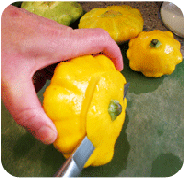Online Magazine
& Cooking Club

In This Issue
Feature Articles
Making heads & tails of
the squash kingdom
6 Tricks to Take the Bland
out of Summer Squash
Zucchini Overload:
how to turn over-
into advantage
5 Fast Ways to Cook Squash +
5 Simple Ways to Dress It Up
In Every Issue
Why We Love It
Top 10 Questions about Squash
The Green Kitchen
Picky Eater Tips
Money Saving Tricks
News from the Farm


Cooking School
Cooking Classes:
Greek Potato Salad
Zucchini Salad Americana
Buying the Best
Storing for Flavor
Prepping Tricks & Tips
Cooking Basics
Recipes, Recipes, Recipes
14 Easy, Creative Dishes Using Summer Squash

























When it comes to squash, some confusion is warranted. All sorts of things are called “squash” that don’t seem to have much in common. The word refers to vegetables soft and hard and huge and small. It covers things striped and solid, in all sorts of curious shapes and in a every hue of yellow, green, orange and brown.
How’s an everyday cook supposed to get a handle on this wildly diverse grouping, and know which to buy at the store, what to do with them at home, what taste to expect, what flavors to add, and so on?
Winter vs. Summer Squash
For starters, understand the distinction between “summer” and “winter” squash. Fortunately, this one distinction provides most of what you need to get a handle on the squash kingdom and, more importantly, to transform a particular specimen into a delicious dish.
|
Summer Squash |
Winter Squash |
|
Thin soft skin is edible; cut and cook with flesh |
Leathery skins are inedible and eventually turn into hard shells; remove before or after cooking |
|
Seeds and pulp are soft and edible |
Seeds are hard and pulp is stringy; remove before eating |
|
Soft tender flesh cooks up quickly |
Dense, hard flesh requires long cooking times |
|
Comes into season in summer |
Comes into season in autumn |
|
Eaten fresh like other summer vegetables (e.g. cucumbers, peppers eggplant); will go bad quickly |
Hard skin and dense flesh make it suitable for long storage–all winter, in fact. Hence the names “Winter Squash” and “Hard Squash.” |
Summer squash are dominated by zucchini, but actually include many other varieties.
Winter squash include pumpkins as well as butternut, acorn and spaghetti squash
Do the Different Sizes Make a Difference?
Just as the different varieties of squash are generally interchangeable, different sizes of squash can be generally be substituted for each other, but again with a few exceptions:
1. Tender Baby Squash–No Substitutions When It’s the Star As with other baby vegetables, baby summer squash are the sweetest and most tender (although Farmer Richard has a different opinion). So if a recipe calls, e.g., for a quick braise of whole baby zucchini to highlight their prized flavor, avoid substituting another sized squash if at all possible. Ditto if a recipe calls for small or medium squash because it will be eaten raw. Don’t substitute a large squash.
On the other hand, if baby squash will just be stir fried with other ingredients, baked in a casserole, or shredded for meatballs, you’re probably safe substituting another size.
2. Large Squash–Scoop Out Seeds and Pulp, Peel if Necessary As squash get bigger, the seeds inside get bigger and tougher, and the pulp around the seeds gets stringier. So when substituting large squash for small, first cut in half lengthwise and scoop out the inner seeds and pulp. Then peel each half with a vegetable peeler if skin has also begun to get thick and leathery.
3. Stuffing Squash–Monster Sizes Best In recipes for stuffed squash, larger sizes are obviously best since their large cavities can be filled with a generous amount of stuffing, creating a good ratio of stuffing to squash. Medium-
For squash that aren’t big enough for stuffing, consider transforming the recipe into a casserole-
Summer Squash–License to Buy Adventurously
Although summer squash are a colorfully diverse lot, they are all fairly similar in taste and can generally be substituted for each other with good success. So it’s a pretty low-
There are just a couple minor exceptions to the substitution rule:
1. Patty pans: Firmer and Denser Patty pans are denser and meatier than other summer squash, so they won’t cook down quite as much, nor will they get as soft in your dishes. This means you can get by with a little less in terms of weight. Also consider cutting in smaller or thinner pieces for equivalent cooking times.
For faster cooking of pattypan’s dense flesh, slice off the top, then cut into thin wedges.
Large Magda squash are ideal stuffers with their broad and deep cavities. Medium-
Scoop the innards from very large squash whose seeds and pulp have become tough.
The denser texture of patty pans make it suitable for a wider range of dishes than the other summer varieties. It can better withstand longer cooking times, for casseroles and sauces. Cooked slices are also firm enough to serve as low-
2. Shape: Adapt Cuts to the Shape The more unique a squash’s shape, the more limited are the cutting options. For example, while all sort of cuts are possible with a straight, even squash like zucchini (see “How to Prep Summer Squash”), a Tromboncino’s curly shape makes it tough to do much besides shred it or slice in full rounds. If the cut is critical for presentation purposes, be sure to get the squash variety called for in a recipe; otherwise, simply cut as closely as possible to the method called for in a recipe.
3. Color: Keep the Palette Pleasing When substituting squash, be mindful of the recipe’s color palette. Although logic says that color shouldn’t affect the taste of a dish, experience reveals more than a casual eye-
The same principle is at work in the recipe for Yellow Squash and Green Pepper Stir Fry (pictured to the right.) The dish would lose something if the green peppers were paired with green zucchini.
Of course, we are talking here about the difference between optimal and doable. In a pinch, use whatever squash you have available. That would always be better than dialing for pizza.
Pork Stir Fry celebrates the colors of freshness and summer.




















The Summer Squash Review
Cocozelle

Patty Pans -
Different Sizes

Green Zucchini

Yellow Zucchini


Monster Zucchini




8-

Yellow Crookneck



© 2009 Culinary Concepts, Inc., Boulder CO


Next Page

Prev Page